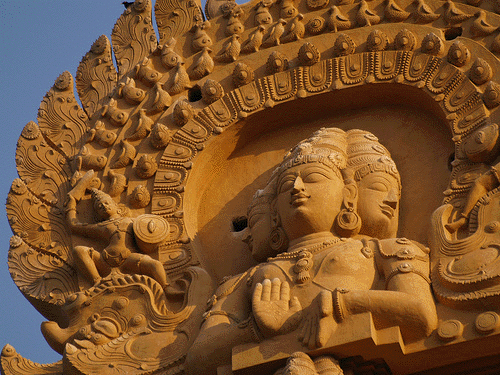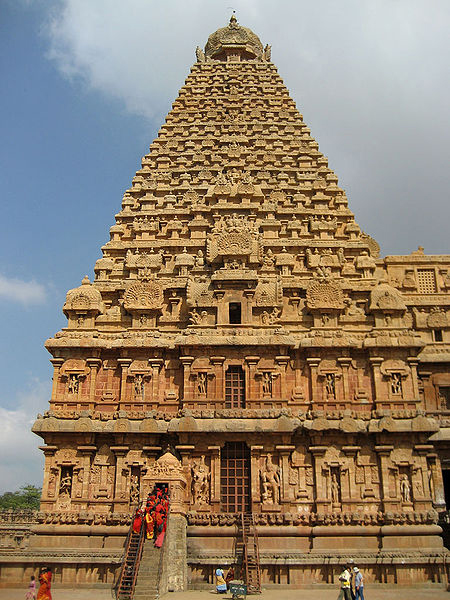
|
|
|
|
Known by several names -- Brahadeewarar, Rajarajeswaram, Peruvudaiyaar Koil, and the Big Temple – this monument is an outstanding example of Dravidian architecture. The 200 foot tall vimanam over the sanctum sanctorum is a testament to the engineering skill of the Cholas. In keeping with the enormous size of the temple, the maha-Shivalinga here is also very large, measuring nearly 13 feet in height. There is a monolithic Nandi too, carved from a single rock and measuring nearly 20 feet in length.
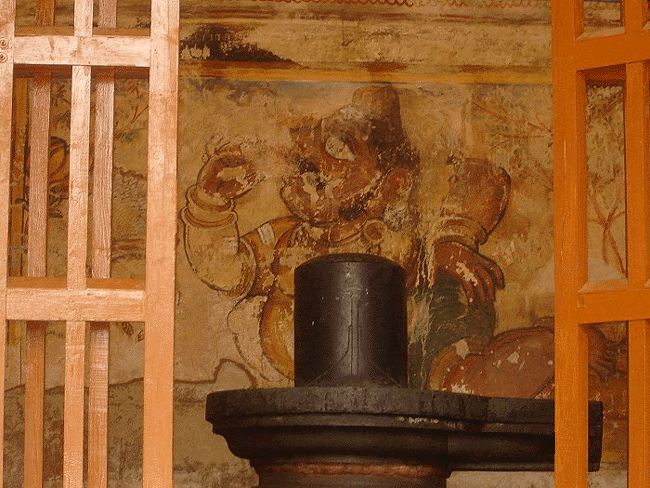
Linga and mural of gana taking prasada Brihadeshvara Temple is dedicated to Lord Shiva, but there are a number of beautiful murtis and paintings of Lord Brahma here. Brahmadeva resides in the sanctum sanctorum as one of the koshta moorthigal, or subsidiary deities worshipped here.

Various Linga So much could be said about the extraordinary architecture of Brihadeshvara Temple that we can't begin to mention even the highlights here. The pyramid-shaped tower has 14 tiers, and it rises overtop the temple sanctum. In a very unusual design, the temple has a square base topped by huge monolithic granite cupolas, which prevent the vimana shadow from ever falling on the ground. The tower's top is carved from a single block of stone, 25 feet high and weighing some 80 tons.
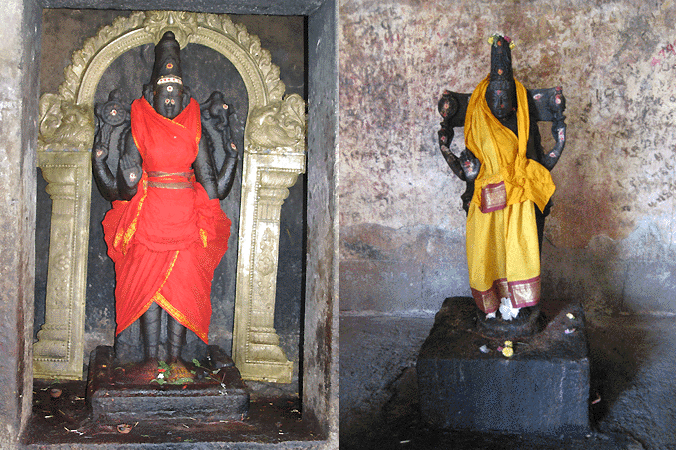
Deities in sanctum The temple sits in the middle of a rectangular enclosure which is entered from the east, through a now dilapidated gateway. The sanctuary walls are double pilastered and elevated on a moulded basement ornamented with lions. Along the sanctum walls are central niches, holding the temple's subsidiary deities. Lord Brahma is on the north, Vishnu on the west, and Dakshinamurti on the south.
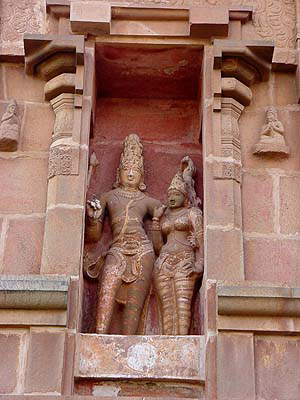
Shiva and Parvati North wall of sanctuary A stone altar with lotus on the top has the Navagrahas carved into the sides. Another small shrine in the southwest houses Ganesha. Suriya and Candra are also represented by very large murtis. Brihadeshvara is one of the rare temples to have murtis for the Ashtadhig Balakas, or [Lords of the Eight Directions (Indra, Varuna, Agni, Isana, Vayu, Niruthi, Yama, and Kubera), and each of these lifelike murtis is approximately six feet tall. There are also a number of bronzes in the temple today, and many others have unfortunately been removed from the temple over the years, including Tripurantaka, Nataraja, Devi and Ganesha murtis.
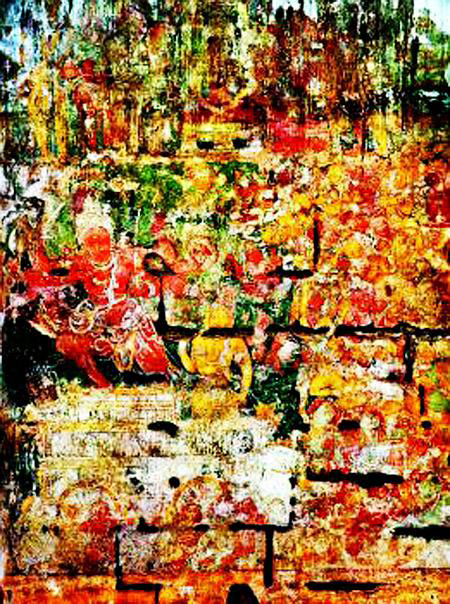
Brahma drivesTripurantaka's Chariot
The passage around the sanctum sanctorum houses a number of exquisite Chola frescos and mural paintings, which adorning the sanctum walls. They depict a wide range of lila pastimes, battle scenes, and divine personalities. The murals are 15 feet tall and 10 feet wide, 1,000 years in age. Located in a narrow and dark passageway that circumambulates the sanctum, the murals were painted under the direction of King Raja Raja I, between 1008 and 1012 A.D.

Sanctum passageway The most famous mural is one that covers the entire northern wall of the sanctum. Considered the masterpiece mural at Brihadeshvara, it depicts a scene from the destruction of Tripura. Lord Shiva as Tripurantaka is seen riding a chariot that is driven by Lord Brahma. Shiva is in aidha pose, fully armed and wielding a bow, with other weapons in his eight arms. He is followed by an army of supporters, including Karthikeya on peacock, Ganesha on mooshika, Kali on lion, and Nandi in front of the chariot. They do battle with a host of aggressive demons, whose womenfolk cling to them. The details of the mural are difficult to see in this photograph, which is a very compact image of a huge painted surface. In this small format, the image becomes a cacophony of shapes and colors. Lord Shiva is the many-armed figure in red, at center left. Lord Brahma, the yellow figure, is facing him, and the two are standing on a white chariot. Shiva is described as having a 'twin expression' -- ferociousness in his eyes, and a sweet smile on the lips. This representation of Siva is rendered according to early Pallava tradition. In the Chola period, Tripurantaka was generally depicted as standing in the abhanga pose, and sometimes in tribhanga, with one leg planted on the head of either the gana Apasmara or on a lion. While Lord Brahma is depicted with one head in the Brihadeshvara mural, we see in the image below another version of the scene. This sandalwood carving from Mysore, c. 1875 depicts 'Shiva as the Destroyer of the Tree Cities of the Demon (Tripurantaka)'. A catur-mukha Brahmadeva holds paraphernalia, and has the chariot reins firmly in hand. This carving has silver fittings, and was probably the cover of a manuscript at one time.

Brahma and Tripurantaka, Mysore The battle between the devas and asuras was a long struggle, culminating in the destruction of Tripura, the abode of the demons. As the devas continued to press the battle forward, the asuras finally joined together their three cities against the siege. Shiva ordered that a chariot be made, from which he would battle the three demon leaders. Lord Brahma himself came to take the chariot reins. Visnu was embodied in the arrow, and Agni as the arrow's tip. Vayu was embodied in feathers on the arrow's rear. All other devas had a place elsewhere in the chariot. Just as the demon cities aligned, and the Pushya nakshatra were properly positioned, Shiva prepared to string his bow with the Pinaka arrow, but sensing that the devas were overjoyed that Tripura was about to be destroyed, he held his arrow. With a smile, Shiva instead burned all three purams. Lord Brahma intervened, asking Shiva to forgive the devas for their wrong thinking. He implored Shiva to release the great arrow, else the devas would get a bad name, and the creation of the magnificent chariot would be for naught. Shiva agreed, shooting the Pinaka at the already burning Tripura cities.
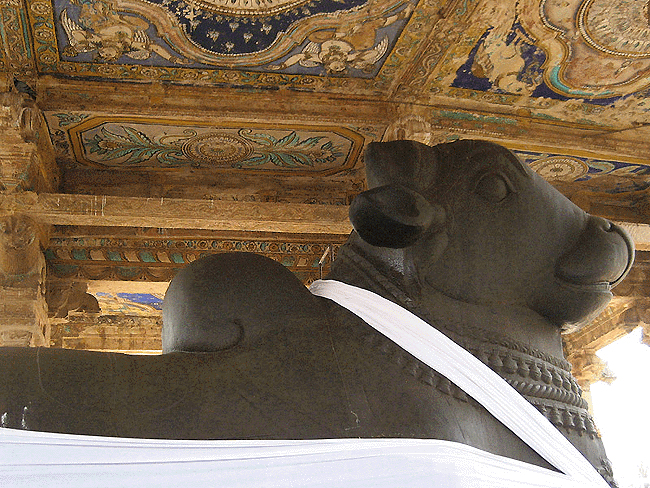
Nandi
The opulence of the Tripura pastime mural is but one example of the richness that manifested throughout this temple complex. Like many Chola kings, Raja Raja I was a great benefactor of the devotional arts, which were gloriously demonstrated in architecture, sculpture, painting, music and dance, as well as deity worship here at Brihadeshvara. The temple was a center that inspired the devotional sentiments of devotees throughout the region. Every evening, they flocked to the temple for puja, the lighting of lamps, chanting of the Veda and Devaram hymns, and honoring of prasadam. The temple enjoyed a large staff of some 600 servants, including Brahmin priests, cooks, gardeners, flower pickers, garland makers, deity paraphernalia craftsmen, musicians, dancers and artists, managers and administrators, etc. All are referred to in the many inscriptions found in the temple, as land, foodstuffs and various goods were endowed to the temple for their welfare. Two long streets (talichcheri) were built solely to accommodate another four hundred dancing women who served the temple.
In this environment of lavish service, Lord Shiva, Lord Brahma, and all the deities in residence were opulently worshipped.
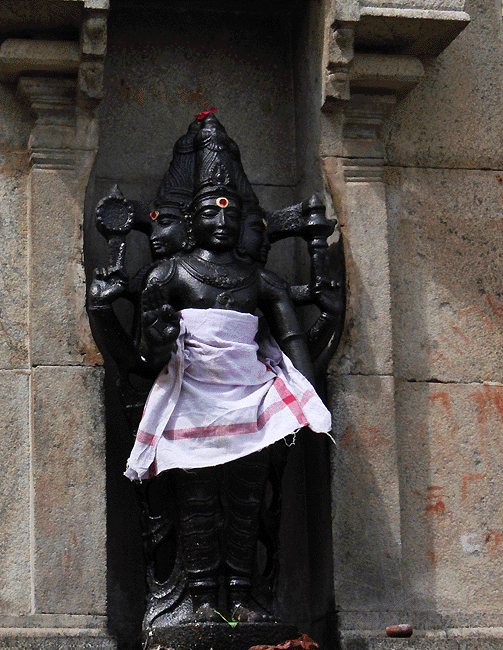
Lord Brahma, Tilaithapathi Temple
Thanjavur town is home to some 90 temples, and Lord Brahma is likely present in some that we have not heard about. We know that he resides in the Tilaithapathi Temple here, where a beautiful black bronze murti is installed and worshipped in a wall niche.
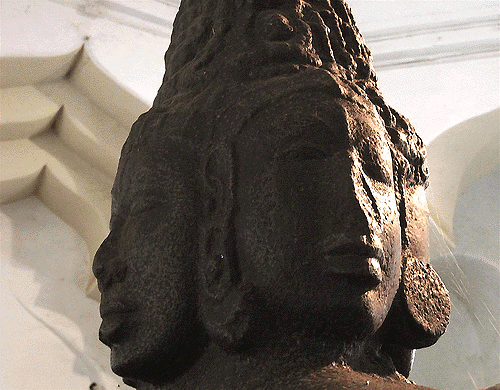
Lord Brahma, Thanjavur Art Gallery Nearby is the well known Thanjavur Art Gallery, which specializes in bronze sculptures. Some of the murtis here came from local temples, dating back as much as 5,000 years. Among the finest bronzes is a large murti of Lord Brahma on a lotus pedestal, positioned inside a courtyard entrance. Elsewhere inside Thanjavur Gallery is a catur-mukha Brahma that appears to be sculpted in stone.
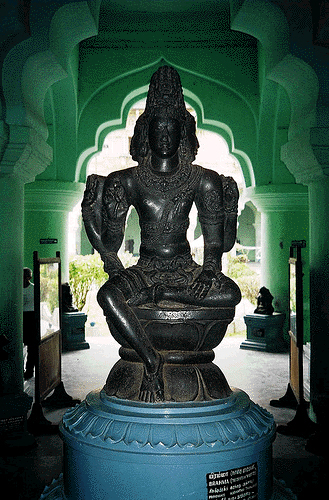
Lord Brahma, Thanjavur Art Gallery
| |
